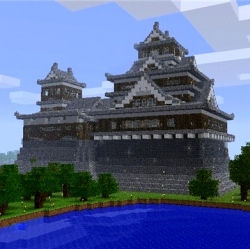
In what Microsoft is calling The Friendly Update, the Mojang-hosted server service Minecraft Realms is being rolled out to Pocket Edition and Windows 10 Edition. While this may not sound particularly remarkable, it brings collaborative Minecraft world creation to mobile devices, including VR, for the first time.
“For the first time players across iOS, Android and Windows 10 can easily play together online, and share their worlds with their friends,” said Sax Persson, studio manager for Microsoft Studios, in his announcement of the update at Microsoft’s E3 event. “We’re excited to unite our community, no matter what device they play on.”
Minecraft users have been sharing servers for years, and some really cool projects have been produced as a result. But never before have regular users, in Minecraft or on any other platform, been able to create things on such a scale that can then be experienced, interacted with and added to in virtual reality, let alone by 11 different users at once.
In effect, it will let users create virtual worlds, games and other interactive spaces without any coding, which can be immediately experienced by themselves and their friends using Gear VRs. And that alone is a big deal for virtual reality.
But this is just the start. Minecraft VR is a brilliant way to experience the game, and already proving very popular with Gear VR owners.
Oculus CTO John Carmack, in particular, is very positive about the game’s potential in VR. At Xbox’s E3 press event, he appeared during the Minecraft segment wearing a Gear VR to demonstrate the game’s features, talking with pride about its importance to the platform.
“I said that Minecraft was my Grail for VR, and this was the most important gaming application that I could be involved with,” he said. “The ability to spin around, take in everything and have the freedom to explore an endless world is what I thought the core of VR was intended to be.”
However, because it’s typically played for shorter stints, Minecraft VR is a pain to create vast structures or spaces in. As a result, the ability to spend time crafting your perfect VR experience on a PC before donning your headset to check it out is going to be incredibly appealing, and we expect Minecraft Realms to be very popular for this purpose.
For some, the product will even become appealing as a collaborative VR creation space, rather than a specific way to enjoy Minecraft, given the unique nature of the offering on mobile VR.
Before long, we’ll have rivals to the service, in the form of other VR apps that you’ll be able to create spaces for and share with your friends. Some of them will probably suck, but some might prove to be really quite brilliant.
At this point, companies will likely look at making it possible to publish VR worlds so that they can be enjoyed by anyone. Minecraft may well get in on this too, assuming they can make it work from a cost point of view. It might be tricky and expensive – servers aren’t all that cheap, and a collaborative world that can host hundreds of people at once will be a pricey offering. However, the demand will be there, and so someone, sooner or later, will figure out a way to make the idea viable.
The resulting collection of user-created VR spaces will effectively be the Geocities of virtual reality. VR will become home to thousands upon thousands of tiny virtual worlds, created by users from all over the globe.
But there will be issues. How will people discover new worlds? And how easily will it be to travel between them?
As a result, someone will probably start to try and join these worlds up, perhaps enabling users to jump between them using portals similar to those in VR internet platform JanusVR. And at this stage, the metaverse will effectively be a reality.
The term, which comes from Neal Stephenson’s seminal book Snow Crash, refers to a collective shared space, visualised as a vast series of virtual urban environments, where users can interact using sophisticated avatars.
It’s basically a VR internet, and although the idea has been attempted on many non-VR systems, no VR platform has yet fully realised the idea.
Some apps have tried a mock metaverse, but these are always held within the confines of one piece of software, rather than a true metaverse that encompasses vast collections of different systems.
As VR progresses, however, it seems likely that content will increasingly be interlinked, building towards a true and wide-reaching metaverse that users can collectively shape.
And while Minecraft VR isn’t going to carry virtual reality into the metaverse on its own, the service has certainly taken a major step towards it.
